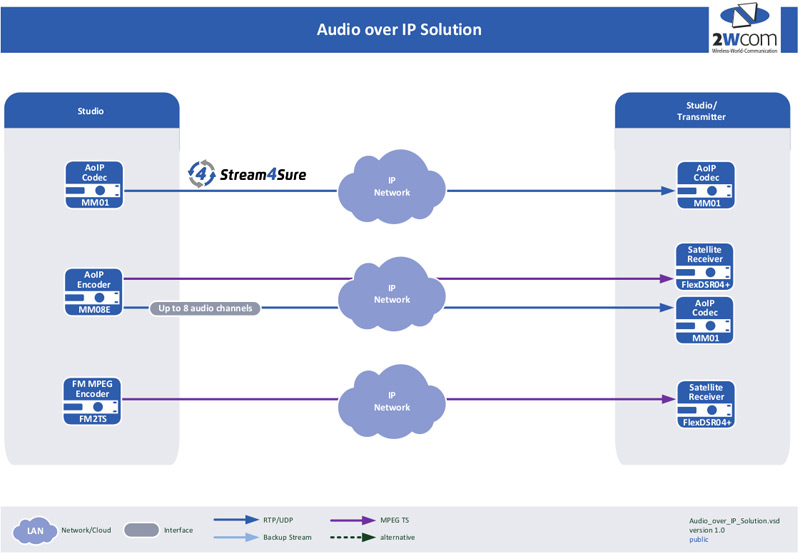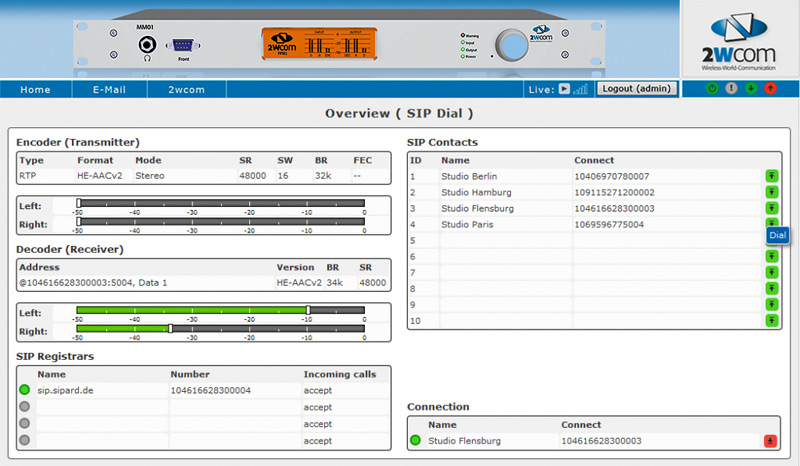AoIP Codec MM01 from 2wcom Systems

During concept phase of the AoIP Codec concentration had been on creating a device which offers perfect support for an effective work in the world of audio networks. The focus was on high compatibility, easy operation, useful features and above all a perfect sound in each case for the given general conditions. As a result, the MM01 is practical and makes it easy for you: It is compatible with all common algorithms, user-friendly and includes a wide range of helpful features, such as SIP (Session Iniciation Protocol), SAP (Session Announcement Protocol) as well as RTCP (Realtime Transfer Control Protocol). Rounded off by a perfect redundancy management the device is flexible integrable in existing system environment – for example: studio to studio links, studio transmitter links (STL) or other forms of audio over IP streaming.
An additional highlight of the further development is a latency control, which allows synchronization up to the microsecond. Furthermore, depending on the selected algorithm, achieving an end-to-end delay less than 10 ms is possible. These functions enable you to handle sophisticated broadcast environments, such as live broadcasting, audio description or in-ear monitoring and even SFN.
To ensure best possible transmission quality, the MM1 provides users with functions as dual streaming (IP packet based redundancy) or the exclusive Stream4Sure (on the audio sample exact synchronization of backup streams of different quality). Quality concept completes Pro MPEG FEC, a feature for error correction by restoring of lost IP packets. Thereby, offering FM rebroadcasting tuner, technicians can use MM01 for monitoring or as a backup.

The MM01 is the perfect multifunctional solution to achieve effectively the best possible quality for the audio signal in the multi-facetted world of audio networks. Of course, best possible sound is not achievable by any kind of compression but quality standard and economy can optimally harmonized, depending on the given conditions. For an appropriate configuration of all settings, the device provides an intuitionally operable web interface.
Furthermore, days of communication problems between codecs, such as studio to studio connections, are over. The SIP feature comfortably supports to ensure establishing the connection between two devices and to negotiate the algorithm. In practice, an interactive and time-efficient test determines which “language” both ends understand optimally.

Which codec for specific framework conditions
It depends ultimately on the general conditions, whether and which compression is the perfect choose for transmission of audio signal. Among other things, the available environment is relevant: is it a small network, a large broadcasting station with subnets and routers or sophisticated live applications?
If the most economical transfer is mandatory, a codec such as AAC with a high degree of compression should be the final choice. To accomplish this, all for human auditory system imperceptible frequency ranges are cut-off audio signals. This method is perfect to achieving best audio quality for human ears if the system environment is less powerful. Bit rates from 192 kbit/s or 224 kbit/s are comparable with the loss-free CD format. As the successor of MP3 the AAC algorithm can be used in equal system environments. Hence, this audio compression is especially in use for MP3 players, music websites and internet radios.
The licensed-bound Codec apt-X represents an attractive compromise between economy and pure sound. The original codec had been in use already 30 years ago for an optimal voice quality in ISDN telephony. With Enhanced apt-X, the codec is now strongly improved and due to the increased resolution perfectly suitable for the professional radio broadcasting over AM, FM, DAB and HD radio.
Enhanced apt-X characterizes a specific method for compression in comparison with other algorithm codecs; compressed in accordance to the requirements of the wireless transmission, the audio hardly has any losses towards the original track after decompression. Thus, the emerging of cascading effects caused by multiple transmission steps from the first transmitter to the last receiver, can be avoided.
By now, the usage of significantly larger bandwidths is possible. Hence, now it is possible to send the perfect sound over “Ethernet airwave” by deactivating sound processing and transferring transparent audio, bit by bit without any compression. For this, the MM01 provides IP-based audio network technologies (Layer 3) for real-time streaming. This can be a proprietary solution, such as Livewire or the standard based, flexible and license-free solution Ravenna. Considering the advantages of this technologies are perfect for broadcasting stations, concert halls and theatres, both in small networks as well as in larger infrastructures with subnets and routers. A loss-free, professional transmission of the audio signal is possible over the PCM coding (Pulse-Code-Modulation) with a very high sample rate. It allows achieving a latency below 1 ms. GPS and PTP (Precision Time Protocol) allow a sample accurate synchronization for transmitting of audio signals or IP streams. This complies with the requirements of the demanding live applications or in-ear monitoring. Due to the support of the AES3 format, it is also possible to implement an absolute bit-transparent transmission of AES/EBU signals in broadcasting environments or studio environments.
Future of the audio transmission
Definitely mobile applications in connection with AoIP are becoming increasingly more important and enable all kind of users to transmit their content from almost any environment to the broadcasting studio and sound studio. In this context, it is important to mention the OPUS Codec, which becomes more widespread. For this reason, the MM01 is evolving continually. The basis for transmissions of this type is an AoIP capable device in the broadcasting studio and sound studio.
To meet the upcoming additional requirements, 2wcom participates actively in development and integration of the new ACIP2 specification (TECH3326, N/ACIP, AUDIO CONTRIBUTION OVER IP). The purpose of this specification is to achieve compatibility of the devices of different manufacturers. In addition, the possibility is created to connect devices from the “Studio-Transmitter-Line” environment (STL) to the studio to studio environment.
Reason why
A Scandinavian broadcaster has chosen the MM01 for the upgrade of its FM broadcasting network after extensive test series with various devices. The main reason for choosing the MM01 was primarily the exceptionally sophisticated and qualitatively constant audio transmission in the large-area broadcasting network. On the locally given test conditions, the MM01 scored among other things due to its excellent linearity of the frequency spectrum. Furthermore, Integration of the device in existing systems is cost-efficient and convenient to realize. By now, more than 1000 MM01 devices are in use at the broadcasting stations.
 How to resolve AdBlock issue?
How to resolve AdBlock issue?